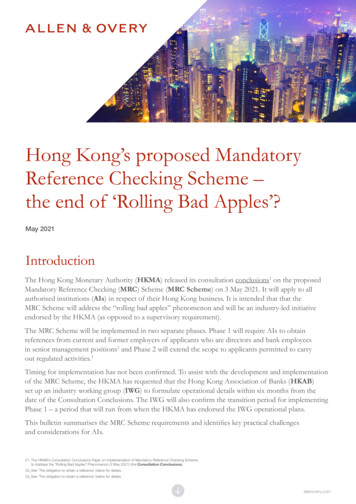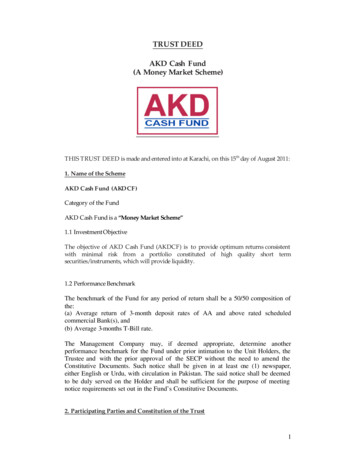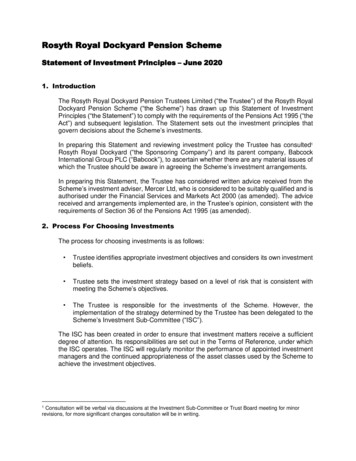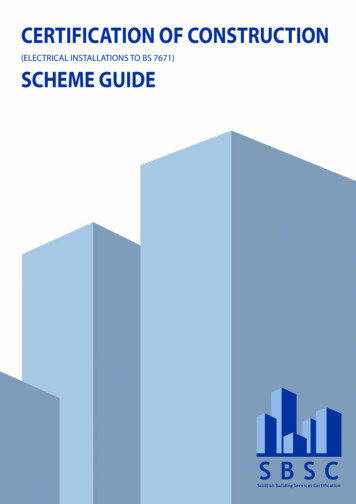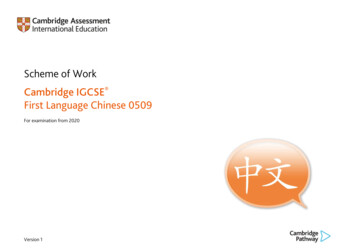
Transcription
Scheme of WorkCambridge IGCSE First Language Chinese 0509For examination from 2020Version 1
In order to help us develop the highest quality resources, we are undertaking a continuous programme of review; not only to measure the success ofour resources but also to highlight areas for improvement and to identify new development needs.We invite you to complete our survey by visiting the website below. Your comments on the quality and relevance of our resources are very importantto us.www.surveymonkey.co.uk/r/GL6ZNJBWould you like to become a Cambridge International consultant and help us develop support materials?Please follow the link below to register your for/teachers/teacherconsultants/ IGCSE is a registered trademarkCopyright UCLES 2018Cambridge Assessment International Education is part of the Cambridge Assessment Group. Cambridge Assessment is the brand name of the University ofCambridge Local Examinations Syndicate (UCLES), which itself is a department of the University of Cambridge.UCLES retains the copyright on all its publications. Registered Centres are permitted to copy material from this booklet for their own internal use. However, wecannot give permission to Centres to photocopy any material that is acknowledged to a third party, even for internal use within a Centre.
ContentsContents . 3Introduction . 4Developing reading skills . 7Developing writing skills . 11Reading for ideas. 16Reading a variety of texts . 19Selecting, analysing and using information . 21Writing summaries . 23Classical Chinese . 26Writing composition . 32Discursive and argumentative writing . 36Descriptive and narrative writing . 40
Scheme of WorkIntroductionThis scheme of work has been designed to support you in your teaching and lesson planning. Making full use of this scheme of work will help you to improve bothyour teaching and your learners’ potential. It is important to have a scheme of work in place in order for you to guarantee that the syllabus is covered fully. Youcan choose what approach to take and you know the nature of your institution and the levels of ability of your learners. What follows is just one possible approachyou could take and you should always check the syllabus for the content of your course.Suggestions for independent study (I) and formative assessment (F) are also included. Opportunities for differentiation are indicated as Extension activities; there isthe potential for differentiation by resource, grouping, expected level of outcome, and degree of support by teacher, throughout the scheme of work. Timings foractivities and feedback are left to the judgment of the teacher, according to the level of the learners and size of the class. Length of time allocated to a task is anotherpossible area for differentiation.Assessment objectives (AO)Cambridge IGCSE First Language Chinese has two assessment objectives (AOs):AO1 ReadingR1R2R3R4R5identify and interpret explicit information and attitudesidentify and interpret implicit information and attitudesdemonstrate understanding of how writers use language and structure to achieve effects and influence readersanalyse and evaluate facts, ideas and opinionsselect information for specific purposesAO2 WritingW1 communicate clearly, effectively and imaginativelyW2 synthesise information, sequence facts and develop ideas and opinionsW3 use a range of appropriate vocabularyW4 use tone, style and register appropriate to audience and contextW5 write characters correctly and make accurate use of characters, punctuation and grammar.Guided learning hoursGuided learning hours give an indication of the amount of contact time you need to have with your learners to deliver a course. Our syllabuses are designed around130 hours for Cambridge IGCSE courses. The number of hours may vary depending on local practice and your learners’ previous experience of the subject. Thetable below gives some guidance about how many hours we recommend you spend on each topic area.Cambridge IGCSE First Language Chinese 0509 – from 20204
Scheme of WorkTopicSuggested teaching time (% of course)Suggested teaching time (hours)Developing reading skills10%13Developing writing skills5%7Reading for ideas10%13Reading a variety of texts5%7Selecting, analysing and using information10%13Writing summaries10%13Classical Chinese15%20Writing composition15%20Discursive / argumentative writing10%13Descriptive / narrative writing10%13ResourcesThe up-to-date resource list for this syllabus, including textbooks endorsed by Cambridge International, is listed at www.cambridgeinternational.orgEndorsed textbooks have been written to be closely aligned to the syllabus they support, and have been through a detailed quality assurance process. As such, alltextbooks endorsed by Cambridge International for this syllabus are the ideal resource to be used alongside this scheme of work as they cover eachlearning objective.School Support HubThe School Support Hub www.cambridgeinternational.org/support is a secure online resource bank and community forum for Cambridge teachers, where you candownload specimen and past question papers, mark schemes and other resources. We also offer online and face-to-face training; details of forthcoming trainingopportunities are posted online. This scheme of work is available as PDF and an editable version in Microsoft Word format; both are available on the School SupportHub at www.cambridgeinternational.org/support. If you are unable to use Microsoft Word you can download Open Office free of charge from www.openoffice.orgWebsitesThis scheme of work includes website links providing direct access to internet resources. Cambridge Assessment International Education is not responsible for theaccuracy or content of information contained in these sites. The inclusion of a link to an external website should not be understood to be an endorsement of thatwebsite or the site's owners (or their products/services). The website pages referenced in this scheme of work were selected when the scheme of work was produced.Other aspects of the sites were not checked and only the particular resources are recommended.Cambridge IGCSE First Language Chinese 0509 – from 20205
Scheme of WorkHow to get the most out of this scheme of work – integrating syllabus content, skills and teaching strategiesWe have written this scheme of work for the Cambridge IGCSE First language Chinese 0509 syllabus and it provides some ideas and suggestions of how to coverthe content of the syllabus. We have designed the following features to help guide you through your course.Suggested teaching activities give you lots ofideas about how you can present learners withnew information without teacher talk or videos.Try more active methods which get yourlearners motivated and practising new skills.Learning objectives help your learners by making itclear the knowledge they are trying to build. Passthese on to your learners by expressing them as ‘Weare learning to / about ’.AOsLearning objectivesSuggested teaching activitiesR1R2R3R4Identify voiceused in texts Extension activities provide yourabler learners with further challengebeyond the basic content of thecourse. Innovation and independentlearning are the basis of theseactivities.Learners repeat the analysis for one or more further text(s) (e.g. a poem, an extract fromencyclopaedia, a blog, an autobiography, or newspaper article) and report back theirfindings to the class. Extension activity: Learners role-play the different ‘voices’ in an extract. They identify (orare given a list of) the perspectives involved (as indicated by direct quotations, indirectquotations/paraphrases, suggestions of general/public opinion). Learners identify whichvoices the writer might agree with or be seen as sympathetic towards. (F) Learners discuss what they can tell about the narrator or persona of a narrative textfrom its voice.Independentstudy (I) givesyour learnersthe opportunityto develop theirown ideas andunderstandingwithout directinput from you.Past and specimen papersPast/specimen papers and mark schemes are available to download at www.cambridgeinternational.org/support (F)Specimen papers 2020 Paper 1 Section 1Past papers, specimen papers and mark schemesare available for you to download at:www.cambridgeinternational.org/supportFormative assessment (F) is on-going assessmentwhich informs you about the progress of your learners.Don’t forget to leave time to review what your learnershave learnt, you could try question and answer, tests,quizzes, ‘mind maps’, or ‘concept maps’. These kinds ofactivities can be found in the scheme of work.Using these resources with your learners allows you tocheck their progress and give them confidence andunderstanding.Cambridge IGCSE First Language Chinese 0509 – from 20206
Scheme of WorkDeveloping reading skillsThis unit gives learners practice in reading for gist, reading for detail, reading for specific information, reading to expand their vocabulary, identifying the writer’spurpose, identifying the writer’s voice and identifying register and style.AOsLearning objectivesR1Read for gist (skim)R1R3Read for detail (scan)Suggested teaching activities Learners read unseen, short narrative and informative texts within a time limit. They identify the main points andgive feedback orally or in writing. Learners repeat the exercise with discursive texts, identifying the arguments.Extracts can be taken from, for example, newspapers and magazines explaining ideas and presentingarguments, short stories and novels, or from a selection of 0509 past papers available fromhttps://teachers.cie.org.uk Learners answer ‘Who?’ ‘What?’ ‘When?’ ‘Where?’ (and if relevant ‘Why?’ and ‘How?’) questions about a textthey have just read. Give groups of learners a set of longer texts, so that each learner in a group has a different text (e.g. four textsfor groups of four learners). Each learner reads their text quickly to themselves and gives oral feedback to thegroup of the main points (texts can be differentiated by difficulty). Ask groups true/false questions about thetexts, where groups answer as a team. (I) Learners devise true/false questions related to an extract to ‘test’ other learners’ grasp of the gist of it. Give learners the gist of one or more extracts of text and ask them to identify it from a range of options.(Learners can be differentiated by the amount of information offered or relative similarities of texts.) Learners skim read extracts of texts within a given time limit and match to pictures/images that summarise whatis happening in each. Learners in pairs underline the supporting details in a short story or discursive text that could be removed withoutaltering the story or argument. They explain what would be lost from the text without the underlined material.(They are likely to remember significant details e.g. names, imagery and data.) Give learners in pairs a range of texts containing information about dates, measurements, numbers, etc. Theytransfer the information from the texts to answer a series of questions. The texts can be taken from any relevantarticles/texts from study in other subject areas.Cambridge IGCSE First Language Chinese 0509 – from 20207
Scheme of WorkAOsR1R2R3R4Learning objectivesRead for newvocabularySuggested teaching activities (F) Give learners a range of texts containing information about an area. Ask them to identify relevant activities fora given person in a given situation, for example, information on local clubs for boys and girls of different agegroups and/or local attractions and places to visit. Learners discuss in pairs which activities would be available for different family members – varying ages,availability etc. (differentiate by complexity of texts, detail and criteria.) Extension activity: Following on from the previous activity, learners identify which activities are open to aparticular person and draw up a timetable outlining what they can do when. This is an opportunity for crosscurricular links e.g. using relevant articles/texts from study in other subject areas. Give learners a passage containing some unknown words (not more than ten) to underline as they read.Learners work out the probable meanings from:o similarity to known wordso similarity to words in other known languageso contextual clues Learners record new words, giving synonyms or paraphrases to show their meaning. (F) Learners use the new words in a sentence to illustrate and reinforce the understanding of meaning. Learners scan the front page of a newspaper for up to ten words they don’t know or think others might not know.Using a dictionary they look up and record the definition. Pairs or groups of learners then challenge others towork out the definition of the word(s). Give learners / learners create possible alternative definitions from whichthe correct one has to be selected in the context of the piece. Give learners matching exercises for new words and their definitions. (I) Give learners cloze (gap-fill) exercises with unknown words removed. They are told the missing words afterthey have provided their own, and compare them. Use of idiomatic phrases( 成语) effectively is one of the ways to show learners’ abilities. Give learners a textcontaining some unknown idiomatic phrases, list them and cover the idiomatic phrases; give learners a fewoptions, ask learners to choose the correct one. Learners work on an exercise to complete a story by filling in blanks using appropriate idiomatic phrases. The class discusses the rationale behind each idiomatic phrase and the meanings and implications of them.Cambridge IGCSE First Language Chinese 0509 – from 20208
Scheme of WorkAOsR1R2R3R4R1R2R3R4Learning objectivesUnderstand thepurpose of textsIdentify voice used intextsSuggested teaching activities Use of a Chinese paper dictionary /on-line dictionary is one the basic skills learners need to have. Give learnersa passage containing some unknown words (not more than ten), ask the learners to use the dictionary to find outwhich explanation is the right one for the unknown words in the context. Give learners three texts: a leaflet (informative), a political speech (persuasive) and a charity letter (appeal).Learners discuss in small groups what the purpose and intended audience is for each text. Class discusses howevery piece of writing is for a purpose and has an intended impact on the reader, and how this determines thetext’s style and structure. Learners undertake a ‘Language trawl’ to create a class/group resource. For example, ask learners to find atleast three texts which they feel have different purposes/intended audiences. Learners then group the textsaccording to similarities and differences, noting and recording these e.g. using a Venn diagram. (Differentiatethrough groupings and interrogation of texts specified. For example, at a basic level ask learners to identifyaudience and/or purpose, extending to begin to identify and even explain features/examples of deliberatelanguage choice.) Texts identified can be retained to use as a resource for activities later in the course. Give learners a variety of short extracts to read, such as a diary entry, science article or news report. Suitabletexts can be found online, in news media, in local newspaper reports, in opening extracts from first-person shortstories or novels, or in 0509 past papers on School Support Hub www.cambridgeinternational.org/support Learners collect evidence of the writer’s presence, i.e. how subjective or objective, how reflective or factual thetext is. Learners give a score of 0 (lowest) to 5 (highest) for strength of voice in the text and how this relates to thegenre. Learners in pairs identify the ratio of the active voice to the passive voice in different genres of text, and drawconclusions as to how this affects the voice of the text as a whole. (F) Learners discuss what they can tell about the narrator or persona of a narrative text from its voice. (I) Learners repeat the analysis for one or more further text(s) (e.g. a poem, an extract from encyclopaedia, ablog, an autobiography, or newspaper article) and report back their findings to the class.Cambridge IGCSE First Language Chinese 0509 – from 20209
Scheme of WorkAOsR1R2R3R4Learning objectivesRead to identifyregister and styleSuggested teaching activities Extension activity: Learners role-play the different ‘voices’ in an extract. They identify (or are given a list of) theperspectives involved (as indicated by direct quotations, indirect quotations/paraphrases, suggestions ofgeneral/public opinion). Learners identify which voices the writer might agree with or be seen as sympathetictowards. Learners in pairs study two texts which are the same genre and have similar content but different registers, e.g.a dialogue between teenage friends and a dialogue between a teenager and a parent/teacher. Learners makenotes and give feedback on differences of vocabulary, grammar and structure. Give learners similar information – e.g. description of a (famous) place – presented in different forms, perhaps asliterary fiction, guide book extract, holiday brochure and a letter to a relative. At a basic level, learners matcheach piece to one of the contexts listed by the teacher and report back findings (e.g. ‘Which text might be from aguide book?’ ‘How can you tell?’). (F) Learners work in groups to analyse one of the different styles and then present their feedback on one of thetexts, with examples, to the rest of the class. Learners read aloud some of the texts and the class discuss how tone relates to style, i.e. how emotion, or lackof it, is conveyed through syntax and vocabulary choice. Class discusses which genres typically use imagery and which do not, and the reasons for this. Extension activity: Learners in pairs role-play further dialogues to highlight different registers.Cambridge IGCSE First Language Chinese 0509 – from 202010
Scheme of WorkDeveloping writing skillsThis unit consolidates learners’ existing writing skills and is designed to build confidence in the basics of the Chinese language: parts of speech, types of sentencesand sentence structure, paragraphing, grammar and spelling. It introduces to learners the ideas of audience, tone and register, as well as how writers make use oflanguage through imagery.AOsLearning objectivesR1R2R3R4W4Communicate with theaudienceW1W2W3R4Selecting vocabularySuggested teaching activities Learners read short extracts of different types of writing e.g. newspaper reports, diary extracts, blogs, magazinefeatures, letters, textbooks, travel brochures, instruction manuals and emails, and sort according to the audience(likely reader). They discuss findings in groups and suggest the reasons readers might have for reading eachtext, or the context in which the text might be read (e.g. finding out what has happened in relation to a recentincident, looking back at an earlier experience, or researching possible destinations for a visit or holiday). Learners identify the features of the text (e.g. vocabulary, syntax, punctuation, sentence length) which makeeach text appropriate for its target audience and their reasons for reading. (F) Learners write short texts on a similar topic to contrasting audiences e.g. two postcards from holiday – one toan elderly relative and one to a friend, or a post complaining about an aspect of school to a teen discussionforum and a letter to the head teacher complaining about the same thing. Groups of learners/whole class listens to learners reading their texts and consider how they differ. (I) Learners transform the style and register of short texts to adapt them for a different audience and context, e.g.change an email to a formal letter. Extension activity: Pairs write a short dialogue around a phrase to illustrate their interpretations. Begin the lesson by performing some dramatic action with strong feelings, e.g. walk into the classroom angrily,slamming the door. Ask the class to write a paragraph describing what happened, being careful to choose thecorrect words. Learners read their responses, and they are compared and judged by the class. Give individual learners different instructions such as ‘sneak across the classroom’, ‘scuttle across theclassroom’, ‘skip across the classroom’, ‘stride’, ‘tip-toe’. The rest of the class identify the verb and action given.Give learners lists of synonyms for words in a short passage. They rank order them for closeness to the originalword, and then again for strength of meaning.Cambridge IGCSE First Language Chinese 0509 – from 202011
Scheme of WorkAOsW1W2W3W4W5R4Learning objectivesStructure andsequenceSuggested teaching activities (I) Learners watch a film clip and write a half-page report on the event they observe. They read their reports outand the class comments on how the same incident is reported differently, according to the vocabulary used. Extension activity: Different information is given to each half of the class about the characters concerned in thefilm clip. For example, for a scene which depicts someone in an office looking through a desk’s contents, givehalf of the class details to suggest the person searching is a villain. The other half is told that this is the hero inthe villain’s office. Compare learners’ reports in terms of vocabulary choices. (F) Learners replace underlined words in a descriptive text with more precise (or more evocative) ones. Learners in pairs label a picture of a person using precise vocabulary to describe their features and clothing.(For differentiation, learners can use a thesaurus or word bank created by the class in advance.) Display picturesfor comment by the class. Alternatively, learners write labels to describe a picture which other learners then try tomatch to the original picture. Learners look at some short (complete) texts in the forms used in the first activity, to identify the order of thematerial and how it differs for each form, e.g. some have an introduction, some use the material chronologically,some repeat the main points in a conclusion. Learners’ feedback is collected on the board followed by adiscussion of why and how the form and audience determine the structure of a text. Elicit the definition of a paragraph and its structuring role in a text. Learners find examples of longer and shorterparagraphs in the texts and discuss the reasons for this, e.g. news reports use very short paragraphs. Demonstrate paragraph building, e.g. according to the PEE chain method: a Point (topic sentence) is developedinto a paragraph by the addition of Explanation, Evidence, Evaluation, or Elaboration to support it. Learners thenpractise paragraph building. Learners in pairs/groups create paragraphs connected to the same subject, given different points or topicsentences. Give learners a list of connectives (关联词语), ask them which connectives can be used to join the sentences,and which connectives can be used for joining the paragraphs. Give learners some short phrases or sentences, ask learners to use the connectives (关联词语) to join them intoa complex sentence. Learners need to be able to explain the relationships between clauses, such as choice 选择关系, reason 因果关系, progression of meanings 递进关系 etc. Give learners some sentences, ask them to use the connectives (关联词语) to link them into a paragraph.Cambridge IGCSE First Language Chinese 0509 – from 202012
Scheme of WorkAOsW1W2W3W4W5Learning objectivesWrite in differentgenresSuggested teaching activities Learners choose from a list of connectives (关联词语) to join a number of paragraphs into a cohesive text. Learners reconstruct a news report which has its paragraphs in the wrong order by putting numbers againsteach. The same activity can be used with recipes or science experiments with the stages mixed up. (F)(I) Learners explain a procedure with which they are familiar, and that consists of different steps, to the class(perhaps something they know how to do well as a result of a hobby/pastime (e.g. a keen kayaker might explainhow to save someone who has fallen into the water). They may use visual aids to support their explanation. Extension activity: Learners in pairs instruct each other on how to carry out tasks such as tying a tie/pair ofshoelaces as if via video link (i.e. they have to be precise, and can’t say ‘take that one and put it there’ etc.). When both learners in the pair have completed their task, they write their instructions for how to carry out theprocedure. The instructions are compared or tested by other pairs of learners. Give learners in pairs or groups a grid to fill in which lists genres of writing and their features. (Typically featuresof style might include sentence length and type, kind and level of vocabulary, paragraph length, degree offormality, degree of objectivity, grammar features, punctuation features.) Learners match the features to a genre. (I) Alternatively, having worked one example genre as a class, learners identify features of one or more furthergenres. Class agrees on definitive outcome(s). Learners then use the completed grid to review and redraft a previousdraft of their own writing into a particular genre. (F) Give the class a topic, e.g. hurricanes, and each pair or group of learners writes a paragraph about it in adifferent genre, e.g. narrative opening, news bulletin, science article, or charity appeal. These are then read toand discussed by the class. (I) Learners produce a piece of writing on a different topic in imitation of the features of a model they have beengiven. Extension activity: Give a short diary template to individual learners. Learners rewrite the diary according toselected roles (each learner should pick two or three roles representing different social ranks).Cambridge IGCSE First Language Chinese 0509 – from 202013
Scheme of WorkAOsLearning objectivesW1W2W3W4W5Write in differentvoices and withdifferent viewpointsW3W4W5Improve style andaccuracySuggested teaching activities Explain that some tasks require learners to adopt a persona and role so that they use a wider range ofvocabulary than they normally would e.g. so that they can show an understanding of meaning and character in atext. Learners suggest ideas for how different voices would use language (e.g. a head teacher, angry resident,enthusiastic tourist) and why. Learners improvise or prepare an initial dialogue e.g. a customer complaining to an assistant in a shop. In pairs,learners develop the situation further e.g. they role play the assistant reporting the incident to the shop manageror explaining to an older relative, the assistant/customer discussing with a friend later. When enough detail of theincident has been established, assign learners in group roles and tasks, such as writing a letter of complaint fromthe customer to head office, writing the manager’s report to head office, or writing the assistant’s interview with aregional manager following the incident. Extension activity: Learners identify sections from different groups’ texts in relation to the incident – Who iswriting? How can they tell? How convincing is the report? Learners select one section of text they feel could be modified to sound more like the voice of the writer andsuggest changes
Narrative writing Learners in pairs study a piece of narrative writing to identify and analyse the effect of the narrative devices (e.g. Elicit from learners the purpose of using dialogue in narrative writing and link this to viewpoint and character, the best place to use it, the rules for its punctuation and layout.
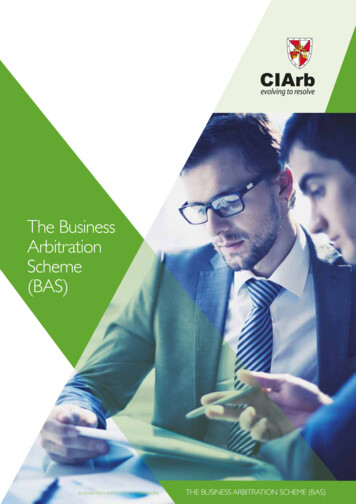

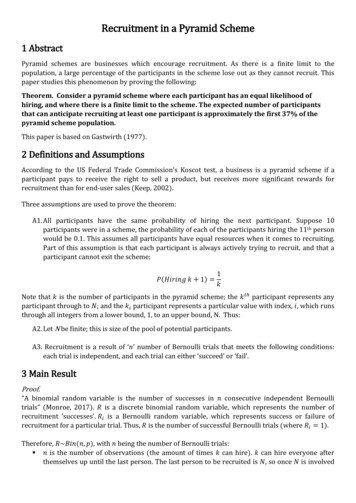
![[Title to come] DSP Dynamic Asset Allocation Fund](/img/24/dsp-dynamic-asset-allocation-fund.jpg)
